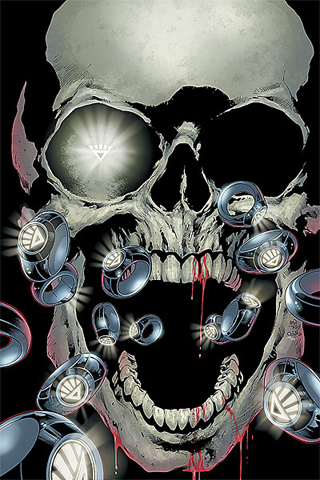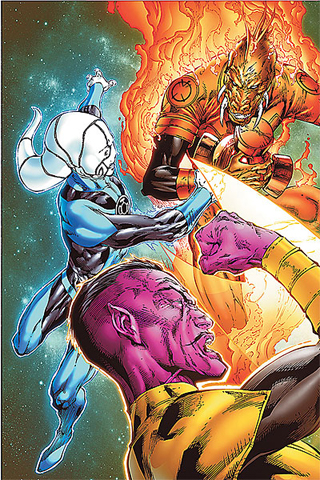Blackest
Night #1
writer:
Geoff Johns
artists: Ivan Reis and Oclair Albert
If it's any consolation, it doesn't seem like Black Hand intends to make Thomas and Martha Wayne into Black Lanterns. Perhaps cradling Bruce Wayne's skull is enough for him; to know that he has the potential to bring back the best of the heroes, which, interestingly, doesn't happen here, either.
Don't worry, though; Blackest Night #1 brings back everybody else, as the dead finally rise in accordance with Oan prophecy. And you know how you know that things are not as they should be? Because the Guardians say, "perhaps Ganthet was right."
All that may seem a little inside to those who aren't as steeped in DC Comics as much as Geoff Johns, Mark Waid, Tom Galloway and myself are. (Yeah, even that joke is pretty inside.) But that's the point of a series like Blackest Night. You'd think the weak-willed dilettante readers need not apply.
Yet even with a cast of at least hundreds, dead and undead, Blackest Night #1 should satisfy old and new readers alike. Mainly because it's a fast-paced, densely packed story with art that's always top-notch, if quite often horrific.
Johns really does have an encyclopedic knowledge of the last twenty-five years or so of DC lore, but he picks and chooses what still exists in continuity. Under his watch the last few years, Green Lantern has been rebooted, rewritten and revised in the service of this story. None of those years matter, as Johns sums them up pretty nicely here, laying out who the Lanterns are, what their status quos are, and then … who they've lost.
The story jumps around to other heroes, too, which should fill readers with dread. Everybody's gathered around graves, mausoleums or crypts, and, with superstar or soon to be superstar artist Ivan Reis, Johns deftly gives us tastes of the circumstances of their survivor's guilt.
That characterization lifts this up beyond exploitation for sales. We know zombies are hot. We know they keep hitting some chord in the current culture. But despite how horrifying some of this book is, it's about the living, and in a very real way. Superman and Superboy came back from the dead, but they couldn't save their adopted Earth father from a heart attack. Green Lantern could rebuild Coast City, but he couldn't restore the lives lost.
In one of the most jarring sequences, the recently returned from the dead Flash asks Green Lantern how many heroes have died in his absence - twenty-four years our time and probably about five years DC time. The Lantern's ring obliges with a green diorama and it is startling how many heroes have died and stayed dead. Until now.
Though you don't need to really remember it, this picks up on an element laid out back in Johns' Infinite Crisis, that death had become a revolving door and something would be ticked about it. Finally, that's come to fruition, and it's nice to see a single writer carrying through from ideas planted years ago. As long as that doesn't drag us into buying a whole bunch of other books.
Johns
promised that you didn't have to read any other books to
enjoy this story, and that's more or less true.
I'm
holding out that you do want to go back and get the
Prologue in Green Lantern
#43, but you can probably skip Blackest Night:
Tales of the Corps #1 out this same week.
It's
not a bad book; it's just inconsequential and really for
completists as it tells some back stories of members of
other Corps, none of which have any bearing on what's going
on.
What we need to see is just how much of their pasts the Black Lanterns legitimately retain. Some of these resurrections will break your heart if these really are heroes (and a few villains) angry at the living. It seems pretty hopeless.
Then again, there's this Blue Lantern Corps hanging
around…
By the way, in case it needs to be said, this story
is not appropriate for kids -- if you've
got a young Green Lantern fan at home, go back and get him
the Green Lantern Showcase book. Those stories still hold
up pretty well.
Hey,
write to us and let us know what you think!
|







